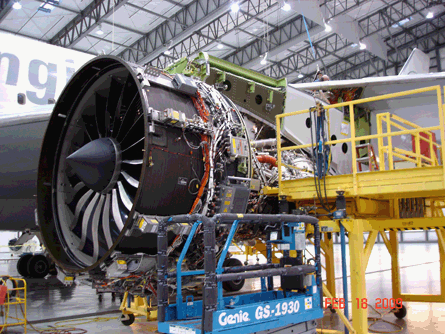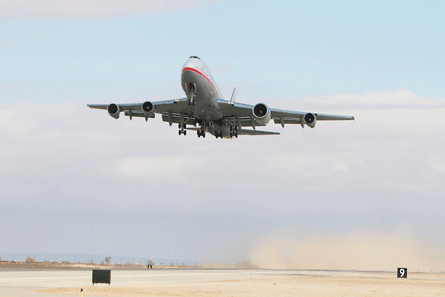Only a year ago, on 29 February 2008, General Electric successfully ran the first engine to test that launched the certification phase of the GEnx-2B programme. The original goal was to complete certification for the bleed-air turbofan, rated at 67,000lb thrust (300kN), later this year, and for it to then enter flight tests with the Boeing 747-8.
But GE's timetable was overtaken by events at Boeing. A 57-day strike by the International Association of Machinists and Aerospace Workers ate up two months of schedule. Then, a combination of unexpected engineering challenges and a shortfall of engineering resources wreaked havoc. Now, the 747-8 Freighter's first flight is expected in late 2009.
In early March, GE was only finishing preparations on the ex-Pan American Airways 747-100 flying testbed for flight tests. A GEnx-2B, the fourth engine produced for the test programme, will be installed on the left wing.
 |
|---|
© General Electric |
Schedule lapses may put a dent in the programme's finances, but they offer the engineering staffs throughout the supply chain the luxury of unexpected time. So it is with the GEnx programme.
The first version - the GEnx-1B, one of two engine types powering the 787 - only completed testing aboard the same flying testbed on 7 November, or nearly two years after the flying tests began. Boeing's 787-8 is running at least 18 months behind schedule, but first flight is now expected in the second quarter.
FLIGHT TESTS
The GEnx-1B completed a three-phase series of 52 flight tests consuming roughly 250 flight hours on 7 November. GE says it is working to develop a product improvement package to bolster the sustainability and reliability for the GEnx-1B. Increasing thrust is not one of the reasons driving the improvements, GE says. The package will enter flight tests on the 747-100 flying testbed in a "year or two".
For GE's flying testbed staff in Victorville, California, completing the baseline GEnx-1B flight tests only marks the midpoint of a three-year test programme for the full GEnx family.
The GEnx-2B is now being prepared to enter a flight-test phase of similar length. On the first week of February, GE completed a series of final power calibrations on Engine 4, finishing the ground-test phase and allowing the flight-test period to begin.
Around 14 February, GE was preparing to ship the engine by truck from Peebles, Ohio, to Victorville - normally a four- or five-day road trip.
GE's flight-test organisation in Victorville - based on the site of the former George AFB - then began the process of installing Engine 4 on the company's 747-100 flying testbed, with the goal of achieving first flight by "mid-Marchish", says Al Krejmas, head of flight testing.
Not surprisingly, the installation process for the GEnx-2B on the 747-100 is greatly simplified compared with its predecessor - the bleedless GEnx-1B. The GE team went to extraordinary lengths to adapt the 747-100 to play its assigned role in the GEnx programme, especially for the novel features of the GEnx-1B system.
 |
|---|
© General Electric |
For example, the 787's unique electrical system alone required a two-year design and build process to install the GEnx-1B on the 747-100, Krejmas says. It was necessary to dramatically expand the 747-100's on-board power supply. GE increased the capacity of the flying testbed's electrical load bank to handle 640kW of power.
"We built up the size of the feeder runs all the way through the wing and through the fuselage and the transfer for the loadbank itself," Krejmas says.
With the 787 engine architecture calling for electrical ground-start, the GE team also had to modify the aircraft with a temporary breadboard circuit system. "It's an electric start engine instead of bleed, so you've got to power-cool the engine to start and once the engine gets to idle it flops over and then you can extract power from it," Krejmas says. "So it's a fairly significant modification. I mean that was a two-year thrill."
In addition to the electrical modifications, the 747-100 crew had to design a temporary hydraulic load bank for the GEnx-1B tests as the 787 systems run on 345bar (5,000lb/in2) versus 207bar for other systems, including the 747-100. "That was a fairly significant modification, but it wasn't as complicated as the electrical side," he says. "I don't want to understate it. It took a little bit of thought but we came up with an elegant solution even though the rest of the ship was 3,000lb/in2."
The installation process for the GEnx-2B is expected to be far simpler. For one thing, it carries the same bleed-air plumbing found on previous-generation engines. The 747-8's systems also require substantially less power from each engine, a difference that also greatly reduces the modifications required to the 747-100 testbed.
"It's not as technically challenging as the -1b was," Krejmas says, "and it's very much in our experience base. It's very similar to flying a GE90 or a CFM56 - or a CF6 for that matter."
The GEnx-2B includes features that are a generation ahead of even the GE90. The 747-8 engine shares the same 10-stage compressor, single-annular combustor and two-stage high-pressure turbine - the three elements of the engine core - with the GEnx-1B. Notably, the fan diameter for the GEnx-2B is narrowed from 2.81m (111in) to 2.66m, allowing one fewer stage in the booster and low-pressure turbine. Both GEnx engines also share 80% of all line replaceable units and 90% of the same production tooling.
The 747-8's four-engine system requires a full power rating of 70,950lb thrust for each propulsion unit, compared with 84,000lb for the 787.
GE's experience in previous flight-test programmes with the GE90 and GEnx-1B will certainly be of great value for the 747-8 programme. But the inherent differences that come with any new engine, even within the same family, requires Krejmas's team to design a very different flight-test programme.
"We approach it like a new engine because it's a different thrust, different diameter fan, but it still functions the same," Krejmas says.
ADJUSTMENT
A particular difference in this case is the adjustment for the GEnx-2B's N1 rate, which measures the speed of the all-new low compressor system. As the GEnx-2B features a smaller-diameter fan than the 787's powerplant, the shorter fan blades must spin faster, which requires greater acceleration speeds.
"You need to develop the [acceleration] rates for burst chops and operability as its own unique engine because it is," he adds. "Its [acceleration] rates will be a little different, faster or slower."
More differences between the 787 and 747-8 engines must be accounted for within the full-authority digital engine control system. The -2B's smaller diameter and condensed booster and low-pressure turbine stages will require changes to the FADEC characteristics.
"The way the engine is controlled is the same, but the scheduling of rates and bleed valves is different because the engine is a little bit different," Krejmas says. "It will have to reflect that or accommodate that."
GE has scheduled in about 200-250 flight hours to complete GEnx-2B certification testing. The flight time is also scheduled to consume about 30-35 flights, but that is likely to expand to around 40 as GE works out "sticking points" in the software, Krejmas says.
The total flight-test period extends for seven months. That, says Krejmas, includes several weeks of downtime, as the engine undergoes scheduled maintenance intervals and fixes for software glitches found during flight tests are developed and installed.
The test campaign includes high-altitude tests in Colorado, low-altitude runs in Arizona, icing tests in the Pacific Northwest and a battery of other evaluation points over Edwards AFB, which is adjacent to the 747-100 testbed's base in Victorville.
"It's not solid flying from the time we start all the way to October," Krejmas says. "But the engine will be installed with a couple of down periods while we are waiting for software roll and some basic airplane maintenance to be carried out."
Source: Flight International



















